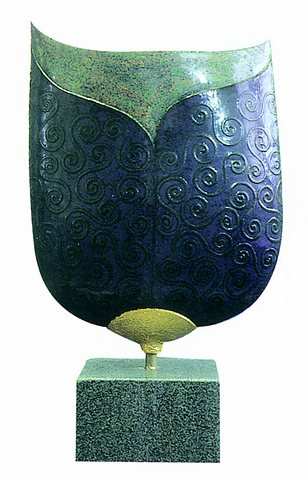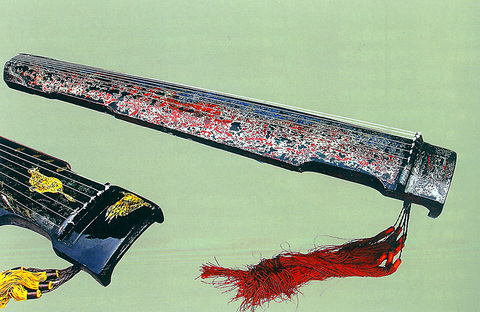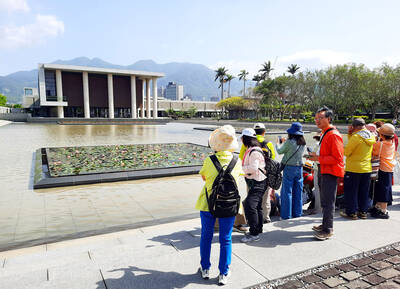The tradition of applying natural lacquer to objects can be traced back thousands of years. In the West, laqueware oftern refers to lacquer articles made in a Japanese style, while people in China refer to lacquered chinaware and point out its distinctive features.
A group of artists from different fields in Taichung, led by renowned lacquer artist Lai Tso-ming (
From this week on, the Taichung County Seaport Art Center (

PHOTO COURTESY OF TAICHUNG COUNTY SEAPORT CENTER
The focus of this exhibition is to present the newest trends of artistic creation of this traditional craft. Out of a collection of nearly 300 pieces, two aspects of this exhibition deserve close attention.
First of all, the colorful and glistening traditional Chinese musical instruments decorated in natural lacquer make their world debut at this exhibition.
It is only a matter of time before popular Western instruments such as the guitar or the violin will be lacquered. The only barrier right now is the concern that Western instruments will be changed by the application of lacquer.

PHOTO COURTESY OF TAICHUNG COUNTY SEAPORT CENTER
So far, the results of experimenting on Chinese musical instruments has been successful and it should be the same for Western instruments.
As Lai points out, professional instrumentalists such as Lin Wen-chi (
Although there has been a long tradition of natural lacquerware art in Asia, the development of this particular type of artwork in Taiwan has been going on for around 100 years, although the style and forms were dominated by artisands in Japan and Fuzhou (
Nonetheless, the recent breakthrough in terms of applying ceramics and natural lacquer to create new objects has brought excitement to the artistic community in the Taichung area.
Taiwan Ware, as Lai and his colleagues have called it, presents artists with alternatives for artistic creation when it comes to applying glazes. From now on, they can use natural lacquer as a new medium to enrich their content of creation as many artists in Taichung have demonstrated so skillfully.
For further details get in touch with the Taichung County Seaport Center, www.tcsac.gov.tw.

When the South Vietnamese capital of Saigon fell to the North Vietnamese forces 50 years ago this week, it prompted a mass exodus of some 2 million people — hundreds of thousands fleeing perilously on small boats across open water to escape the communist regime. Many ultimately settled in Southern California’s Orange County in an area now known as “Little Saigon,” not far from Marine Corps Base Camp Pendleton, where the first refugees were airlifted upon reaching the US. The diaspora now also has significant populations in Virginia, Texas and Washington state, as well as in countries including France and Australia.

On April 17, Chinese Nationalist Party (KMT) Chairman Eric Chu (朱立倫) launched a bold campaign to revive and revitalize the KMT base by calling for an impromptu rally at the Taipei prosecutor’s offices to protest recent arrests of KMT recall campaigners over allegations of forgery and fraud involving signatures of dead voters. The protest had no time to apply for permits and was illegal, but that played into the sense of opposition grievance at alleged weaponization of the judiciary by the Democratic Progressive Party (DPP) to “annihilate” the opposition parties. Blamed for faltering recall campaigns and faced with a KMT chair

Article 2 of the Additional Articles of the Constitution of the Republic of China (中華民國憲法增修條文) stipulates that upon a vote of no confidence in the premier, the president can dissolve the legislature within 10 days. If the legislature is dissolved, a new legislative election must be held within 60 days, and the legislators’ terms will then be reckoned from that election. Two weeks ago Taipei Mayor Chiang Wan-an (蔣萬安) of the Chinese Nationalist Party (KMT) proposed that the legislature hold a vote of no confidence in the premier and dare the president to dissolve the legislature. The legislature is currently controlled

Dull functional structures dominate Taiwan’s cityscapes. But that’s slowly changing, thanks to talented architects and patrons with deep pockets. Since the start of the 21st century, the country has gained several alluring landmark buildings, including the two described below. NUNG CHAN MONASTERY Dharma Drum Mountain (法鼓山, DDM) is one of Taiwan’s most prominent religious organizations. Under the leadership of Buddhist Master Sheng Yen (聖嚴), who died in 2009, it developed into an international Buddhist foundation active in the spiritual, cultural and educational spheres. Since 2005, DDM’s principal base has been its sprawling hillside complex in New Taipei City’s Jinshan District (金山). But